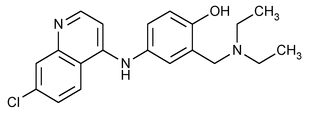Amodiaquine
(am'' oh dye' a kwin).
Phenol, 4-[(7-chloro-4-quinolinyl)amino]-2-[(diethylamino)-methyl]-.
4-[(7-Chloro-4-quinolyl)amino]-
» Amodiaquine contains not less than 97.0 percent and not more than 103.0 percent of C20H22ClN3O, calculated on the anhydrous basis.
Packaging and storage—
Preserve in tight containers.
Identification—
A:
Infrared Absorption  197K
197K —Prepare the standard specimen as follows. Dissolve 20 mg of USP Amodiaquine Hydrochloride RS in 10 mL of water in a separator, add 1 mL of ammonium hydroxide, and extract by shaking with 25 mL of chloroform. Draw off and evaporate the chloroform extract, and dry the residue at 105
—Prepare the standard specimen as follows. Dissolve 20 mg of USP Amodiaquine Hydrochloride RS in 10 mL of water in a separator, add 1 mL of ammonium hydroxide, and extract by shaking with 25 mL of chloroform. Draw off and evaporate the chloroform extract, and dry the residue at 105 for 2 hours.
for 2 hours.
Water, Method I  921
921 :
not more than 0.5%.
:
not more than 0.5%.
Residue on ignition  281
281 :
not more than 0.2%.
:
not more than 0.2%.
Chromatographic purity—
Standard solutions—
To 20 mg of USP Amodiaquine Hydrochloride RS in a glass-stoppered test tube add 1.0 mL of chloroform (saturated with ammonium hydroxide), and shake vigorously for 2 minutes. Allow the solids to settle, and decant the liquid into a second test tube (Standard solution A). Prepare a second solution by diluting 1.0 volume of Standard solution A with chloroform (saturated with ammonium hydroxide) to obtain 200 volumes of solution (Standard solution B).
Test solution—
Dissolve 150 mg of Amodiaquine in 10 mL of chloroform (saturated with ammonium hydroxide).
Procedure—
Apply 10-µL portions of Standard solution A, Standard solution B, and the Test solution to a suitable thin-layer chromatographic plate (see Chromatography  621
621 ) coated with a 0.25-mm layer of chromatographic silica gel mixture. Allow the spots to dry, and develop the chromatogram in a solvent system consisting of a mixture of chloroform (saturated with ammonium hydroxide) and dehydrated alcohol (9:1) until the solvent front has moved about three-fourths of the length of the plate. Remove the plate from the developing chamber, mark the solvent front, allow the solvent to evaporate, and examine the plate under short-wavelength UV light: the chromatograms show principal spots at about the same RF value, and no secondary spot, if present in the chromatogram from the Test solution, is more intense than the principal spot obtained from Standard solution B.
) coated with a 0.25-mm layer of chromatographic silica gel mixture. Allow the spots to dry, and develop the chromatogram in a solvent system consisting of a mixture of chloroform (saturated with ammonium hydroxide) and dehydrated alcohol (9:1) until the solvent front has moved about three-fourths of the length of the plate. Remove the plate from the developing chamber, mark the solvent front, allow the solvent to evaporate, and examine the plate under short-wavelength UV light: the chromatograms show principal spots at about the same RF value, and no secondary spot, if present in the chromatogram from the Test solution, is more intense than the principal spot obtained from Standard solution B.
Assay—
Transfer about 300 mg of Amodiaquine, accurately weighed, to a 200-mL volumetric flask, add 0.1 N hydrochloric acid to volume, and mix. Pipet 10.0 mL of the resulting solution into a 1000-mL volumetric flask, add 0.1 N hydrochloric acid to volume, and mix. Concomitantly determine the absorbances of this solution and a Standard solution of USP Amodiaquine Hydrochloride RS in the same medium having a known concentration of about 15 µg per mL, in 1-cm cells at the wavelength of maximum absorbance at about 342 nm, with a suitable spectrophotometer, using 0.1 N hydrochloric acid as the blank. Calculate the quantity, in mg, of C20H22ClN3O in the portion of Amodiaquine taken by the formula:
(355.87 / 428.79)(20C)(AU / AS)
in which 355.87 and 428.79 are the molecular weights of amodiaquine and anhydrous aminodiaquine hydrochloride, respectively; C is the concentration, in µg per mL, calculated on the anhydrous basis, of USP Amodiaquine Hydrochloride RS in the Standard solution; and AU and AS are the absorbances of the solution of amodiaquine hydrochloride and the Standard solution, respectively.
Auxiliary Information—
Please check for your question in the FAQs before contacting USP.
| Topic/Question | Contact | Expert Committee |
|---|---|---|
| Monograph | Behnam Davani, Ph.D., M.B.A.
Senior Scientific Liaison 1-301-816-8394 |
(SM12010) Monographs - Small Molecules 1 |
| Reference Standards | RS Technical Services 1-301-816-8129 rstech@usp.org |
USP35–NF30 Page 2192

